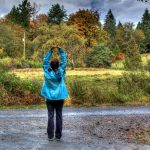Can You Teach An Old Person New Tricks?
 As we continue discussing the practice of meditation, in this blog I’d like to discuss the very important neuroscience principle of ‘neuroplasticity.’ Years ago, when I was a girl, it was understood that after a certain age, the brain no longer grows or adapts. You were “hardwired” with what you had. The belief once was that when we are older, it is just “left in the corner to accumulate dust.” Thanks to imaging technology, we can actually peer into the brain to see things happening. These new diagnostic tools have demonstrated that the brain visibly changes! Dr. Norman Doidge popularized the concept that the brain in fact does have the capacity to reshape itself. Most importantly, he explains the importance of recognizing that the brain is not a stagnant machine. His famous NY Times bestsellers, The Brain that Changes and The Brain’s Way of Healing, have literally opened our minds to these incredibly hopeful ideas. We know now that even into older adulthood, the brain can grow, change, and heal itself! This is neuroplasticity – the brain that changes. The fact is you can teach an old dog (or even a person) new tricks.
As we continue discussing the practice of meditation, in this blog I’d like to discuss the very important neuroscience principle of ‘neuroplasticity.’ Years ago, when I was a girl, it was understood that after a certain age, the brain no longer grows or adapts. You were “hardwired” with what you had. The belief once was that when we are older, it is just “left in the corner to accumulate dust.” Thanks to imaging technology, we can actually peer into the brain to see things happening. These new diagnostic tools have demonstrated that the brain visibly changes! Dr. Norman Doidge popularized the concept that the brain in fact does have the capacity to reshape itself. Most importantly, he explains the importance of recognizing that the brain is not a stagnant machine. His famous NY Times bestsellers, The Brain that Changes and The Brain’s Way of Healing, have literally opened our minds to these incredibly hopeful ideas. We know now that even into older adulthood, the brain can grow, change, and heal itself! This is neuroplasticity – the brain that changes. The fact is you can teach an old dog (or even a person) new tricks.
In the last installment (CLICK HERE to read again), we discussed what I call, “the meditative motion of the mind.” Here, I would like to elaborate on the concept of neuroplasticity with a simple metaphor.
Imagine two families with children the same approximate ages who live back to back from each other. Separating the two houses is just a fence with the gate. Because the children are similar ages, they run back-and-forth between the houses and constantly slam at gate. After a while, the gate is removed to facilitate their visits. Additionally, as they run back-and-forth from house to house, each time they go they tear out a little bit more grass. Over time, there’s no more grass there, and the children have a little brown path that extends between the back doors of each of their houses straight through.
As the kids get older, find other friends, and homework becomes more copious, they stop running back-and-forth. The parents put the gate back up. Eventually over time, because no one‘s running over the path, the grass starts re-growing in that area. It falls into disuse.
This is very similar to the networking connections in our brains. There was a famous neuroscientist by the name of Dr. Donald Hebb. In 1949, he theorized that if two neurons are activated at the same time, the synapse gets stronger, and the neurons build up a stronger connection. He coined the phrase, “Neurons that wire together, fire together.” In my neuro coaching course with Mark Robert Waldman, he say that’s not exactly the current approach, but close. I created a phrase that Mark thought was a better version. I say, “Neurons that flow together grow together.”
This creates neural pathways that free up our brain for higher processes. By developing the repeated practice, that pathway is very easy to “traverse” because it’s been prepped many times. Similarly, as in the example above, the children’s path between their homes eventually became worn and visible with an obvious groove. Whereas, once the children stopped running back-and-forth, because of disuse, the pathway was no longer reinforced. We all know that over time, you can develop a habit. But once you stop there may be that overgrowth. Starting up again you may need to persevere by doing continuous repetitions. However, as we said, the most important thing is to be aware that we can repave new “grooves.” Enjoy NOGA® Sound Solutions audios that can help you create new neuro-paths in your neural garden. Many downloads are free! CLICK HERE to try out one of our many “sound solutions.”
Don’t miss these:
THE SEVEN MINUTE STRETCH MEDITATION (available until May 30th)
OCEAN: 5-MINUTE EXPANDING & CONTRACTING FOCUS MEDITATION (available until May 30th)
With Gratitude,
Rus Devorah


